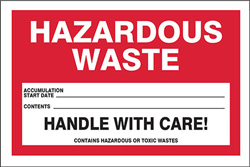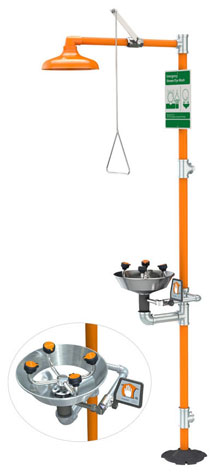



Find all of your laboratory and workplace safety supplies at Safety Emporium!
 Engineering Controls |
 Glossary Index |
 Epistaxis |
| MSDS Topics |
Free Sites | FAQ's | Regulations | Glossary | Software | Suppliers |
| Books | Forum | Poll | Fun stuff | Quiz | Store | |
| Understand your MSDS with the MS-Demystifier | Search ALL our MSDS info | |||||

Get your hazardous waste labels from Safety Emporium.
The U.S. Emergency Planning and Community Right-To-Know Act (EPCRA) also known as the Community Right-To-Know Act or SARA, Title III provides for the collection and public release of information about the presence and release of hazardous or toxic chemicals in the nation's communities.
The law requires industries to participate in emergency planning and to notify their communities of the existence of, and routine and accidental releases of, hazardous chemicals. The goal is to help citizens, officials, and community leaders to be better informed about toxic and hazardous materials in their communities.
To implement EPCRA, Congress required each state to appoint a State Emergency Response Commission (SERC). The SERC's were required to divide their states into Emergency Planning Districts and to name a Local Emergency Planning Committee (LEPC) for each district.
Broad representation by fire fighters, health officials, government and media representatives, community groups, industrial facilities, and emergency managers ensures that all necessary elements of the planning process are represented. If you have a major chemical user or manufacturer in your community, plans to deal with emergency releases have already been developed. Consult your local or regional EPA office for more information.
You can what it's like to participate in an LPEC in several posts on the DCHAS-L discussion list. The time commitments are rather small and it can be very rewarding in both a personal and professional capacity.
A list of over 600 chemicals subject to EPCRA are listed in the Toxics Release Inventory (TRI), which is maintained by the U.S. Environmental Protection Agency (EPA).
EPCRA's key provisions are referred to by their Section in Subchapter J of Title 40 of the Federal Code:

Get your Break glass keyboxes and other emergency accessories from Safety Emporium.

Safety Emporium carries all kinds of eye/face washes, safety showers, drench hoses and more.
NOTE: We may collect a share of sales or other compensation from the links in the following list:
On June 13, 2016, the US EPA published a final rule, Hazardous Chemical Reporting: Community Right-to- Know; Revisions to Hazard Categories and Minor Corrections (see FR 81 FR 38104), adopting the physical and health hazards from OSHA's HCS 2012. The preamble of the rule states that facilities should use the new physical and health hazards on their emergency and hazardous chemical inventory form (also known as the "Tier II reporting form") for chemicals present at their facility starting with 2017 calendar year.
EPCRA or TRI information is not the same as an SDS, but SDS's are part of the required data. EPCRA and TRI data not only includes SDS's on specific TRI substances, but also provides useful information for people concerned about the presence (or potential presence) of chemicals in their community or environment. You can search the TRI inventory in your area with a number of tools available from the EPA web site.
See also: SARA, Toxics Release Inventory.
Additional definitions from Google and Onelook.
Entry last updated: Monday, February 21, 2022. This page is copyright 2000-2025 by ILPI. Unauthorized duplication or posting on other web sites is expressly prohibited. Send suggestions, comments, and new entry desires (include the URL if applicable) to us by email.
Disclaimer: The information contained herein is believed to be true and accurate, however ILPI makes no guarantees concerning the veracity of any statement. Use of any information on this page is at the reader's own risk. ILPI strongly encourages the reader to consult the appropriate local, state and federal agencies concerning the matters discussed herein.